#kkariko tag
Text

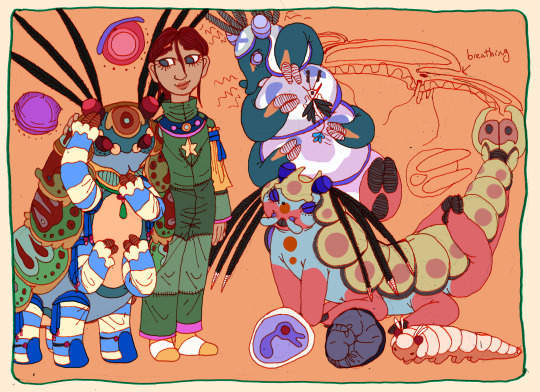
all about kkariko! the infodump is finally ready.
kkariko are soft-bodied invertibrate creatures hailing from a planet known as rika. they're social and familial, living in highly complex family groups. they also make extensive use of tools and accessories in their daily lives. in this way, their behavioral model resembles the behavioral models of humans, but kkariko have some major differences too. an example - kkariko have five "sexes" - or maybe they have no sexes? all kkariko are born "neuter", with the organs used for recreation vestigal in their bodies. however, kkariko can develop into one of four "sexual" sexes to play certain roles in mating and infant rearing. kkariko are able to switch sex multiple times in their lives - it's seen as cosmetic to them. the five socially recognized kkariko sexes are thus: neuter sex, the sex which kkariko are born as. egglayer sex, the sex which can inject pheromones into another kkariko, receive "spermatophores", and lay eggs. inseminator sex, the sex which can make "spermatophores" (actually more like "spear" matophores). brooding sex, the sex which can grow a pouch and grow eggs in it and feed babies using their specialized mouth organ. and finally, protector sex, which also has a special mouth organ and a "spine" for protecting babies.
kkariko babies start life as eggs. eventually, they hatch, and just look like tiny little kkariko. kkariko at such a young age molt many times, and with each molt, they grow more and more. molting intensity usually tapers off after the 27th molt, and size change only gets smaller and molt frequency lower as kkariko age. kkariko have very high infant mortality rates - on average, a clutch of kkariko eggs numbers 20, but its considered lucky if just 4 survive to their 27th molt. rrikrik was in a clutch of 17, but half were laid "out of pouch" (common in almost all kkariko cultures, ensures that brooder attention isn't so divided) and only two ended up hatching.
kkariko have two possible pigments used in their skin. one pigment creates red/pink colors, whilst the other creates blue/gray colors. both can coexist on a single body - like a calico cat - as well as patches of different intensity of pigmentation which can produce darker or lighter pigmentation. these pigments also determine the eye color of kkariko. however, kkariko tend to have a "base color" which affects the tint on their exoskeletons. base color isn't neccesarily the most abundant color on a kkariko.
their bodies are long and squishy, with thick, highly pressured "blood" keeping their muscles and organs in place. kkariko have four pairs of legs, and they alternate between an all-legs undulatory gait and a quadrapedal four beat gait depending on the movement speed and additional actions required of them. they can also stand up on their back legs for intimidation points. but their balance is pretty bad in this state and they can't walk without lots of practice and lower leg strength. at the end of each limb, they have three digits encased in flexible exoskeleton. two digits at the very end of the limb, and one slightly down. these digits can be used to grasp things and manipulate objects, although they're generally clumsy. they also have a long, fat, tapering tail. this tail can be moved independently, but is usually just dragged along the ground behind the kkariko due to its weight. kkariko have a small, round head at the end of their body, where many of their sensory organs are.
kkariko heads are pretty simple. it is on their head that a kkariko has their two pairs of eyes, their primary mucus ducts, their facial palps, their antennae, their mouth, and their first lung. the first pair of kkariko eyes are kind of a hybrid between forward-facing and side-facing. they've got a wide degree of vision. this eyeset sees pretty well, and is generally used to identify objects near the kkariko's face. for this reason, they're nearsighted. the second pair of eyes sits above the kkariko's head and protude upwards. this pair can see nearly 260 degrees around the kkariko, and experiences vision in a very abstracted way, largely triggered by bright colors and movement. these eyes also move independently of each other. as a prey animal, kkariko have evolved this set of eyes to continually watch around them as they use their first set of eyes to look for food and watch their friends. both eyes jut out from the head of the kkariko when in use. the lower set of eyes have a pair of semi-translucent eyelids which occasionally can hydrate the eye, but kkariko generally don't need to blink much. the upper pair of eyes don't need to blink at all, because they have a thick protective coating. both pairs of eyes are retractable, however, and when kkariko are getting ready to go sleep, they retract them back into their heads, with only a thin indigo line showing where they will pop out of later. just below their eyes is their primary mucus ducts, which produce a mucus which covers kkariko skin to keep it from drying out and getting burnt. there are more mucus ducts on their "wrists" and their tail.
the antennae sit behind the second pair of eyes, and are used to sense different types of waves and particles in the air. they process this into audible sound, vibrational information, and electromagnetic data. kkariko can have anywhere from three to five sets of antennae, and can grow an extra pair for sensing pheromones when engaging in sex. antennae can also be used to make a loud whirring noise when rubbed together or a low "clicking" noise when the bases of the antennae (known as "bulbs") grind together in the antennae sockets. these noises are recognized as distinct phones in kkariko language.
the mouth of the kkariko is typically hidden behind their exterior set of palps. these two tentacle-like appendages are used by kkariko to "taste" the air and food, to produce sounds, and to manipulate objects. kkariko palps have much finer motor control than their "hands", so delicate tasks like making art or preparing food are usually done using the exterior palps. behind these palps is the mouth. the mouth of the kkariko is indigo-violet (the color of their blood) and contains a pair of interior palps, two flat "teeth" used for crushing food, and a pair of holes, one used for communication and another used for eating. the interior palps are much thinner than the exterior palps, but serve the same purpose as their exterior friends. its a bit hard to use them to make art, as they can't reach that far outside the mouth. the lower tooth juts out of the mouth and can be moved with a good degree of freedom. when a kkariko's mouth is closed, it pushes up under the palps and the edges of the mouth retract around it, leaving the lower tooth as the only mouth organ visible. when the mouth is open, the lower tooth keeps it by moving down. the lower tooth and the upper tooth mash together to grind food up into a convenient paste, and then the interior palps and kkariko saliva helps move the food down to the esophagus, which is situated below the palps. above the palps is the kkariko's speech hole - closed during eating. kkariko are kind of messy eaters!
kkariko language is, as previously discussed, in part constructed around antennae sounds. but there is a vocal element of it too. kkariko have several groupings of lungs down their bodies, and the first lung sits at the back of their head just below their first cerebral ganglia, which is part of a long network which also travels all the way down their bodies. the lungs of the kkariko intake air from little holes underneath the "lip" of their back exoskeletons. this first lung is connected to the very end of their second exoskeleton plate, which wraps around their head to support it. connected to this lung is an "accordian" organ, which produces a melodious buzzing noise by expanding and contracting with pushed air from the lung out to the noise hole at the top of the kkariko's mouth. tone and intensity can be adjusted, and kkariko will adjust the position of their two pairs of palps and their tooth to make different noises with it. kkariko also rumble their teeth together and smack them together to speak.
on their backs, kkariko grow a heavy plated exoskeleton, used for defense and protection. this exoskeleton stretches from the head of the kkariko all the way down to their tail, ending in a spiked fanlike form which can be used to defend a kkariko. rika is very rich in metal, and heavy metals often enter kkariko diets via the plant life they eat. kkariko have very efficient filtering systems for both water and metals - water is recycled back into the body entirely and eventually expelled in defensive, stinking "farts", and metals are either pooped out in very hard and compacted dry poops, or stored in a specialized organ and used to built their exoskeletons during molts. this is where the colors in their exoskeletons come from - all the metals they eat. some of the metals even oxidize in air, and change color as time moves on! this metallic shell is very heavy, and because of that, kkariko have very strong and muscular bodies. the gravity on rika is also pretty strong, so that also aids in their big buff physiques. the exoskeleton restricts their movements somewhat - kkariko are able to move their limbs pretty freely, and can curl up into a tiny ball, but cannot arch their bodies back that far because the plates on their back prevent much movement. the kkariko in this sheet doing some sort of stretching is probably the extent to how far back a kkariko can stretch without hurting themselves.
kkariko culture is highly complex and varied. rika is hot and arid, and many kkariko live nomadic or seminomadic lives. i'll probably write another post about kkariko cultures, because this one is very long. i guess the most important thing to discuss here is kkariko fashion. kkariko are generally not very modest - they don't need to be, because their shell protects them from most weather. however, all cultures are different, and some kkariko do wear full-body clothing. the most common universal piece of clothing are "armwarmers", which wrap around the limbs like socks. kkariko often wear matching pairs for all eight of their limbs. bibs, hats, capes and aprons are also common, as well as tail aprons which protect the tail from sharp terrain when moving across the ground. tail aprons are a bit like underwear because they also cover genitals.
rowny and rrikrik for reference. rowny is 6ft tall.
v page i made when i was trying to figure out how kkariko communicate + kkariko funny faces v
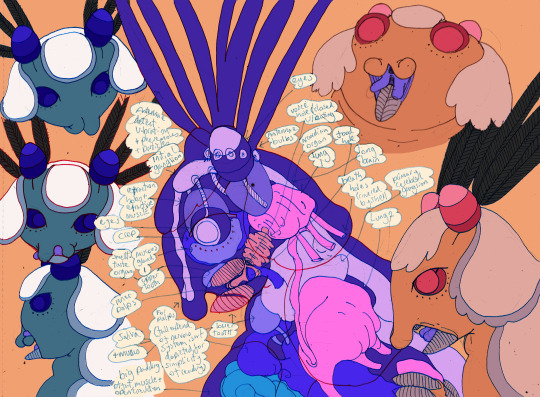
#kkariko tag#xenobiology#speculative biology#sci fi#alien biology#alien species#the kkariko infodump....#new deep kkariko lore - their poop is hard and they fart#writing this two weeks after - “lung” structure has changed a bit. think of it less as a bag and more as a root system
82 notes
·
View notes
Text

photograph of rrikrik garik rr'akrik, kkariko cosmonaut and junior overseer on a minor deep space trawler
rrikrik is wearing a set of striped armwarmers tied with blue cords, a bib symbolizing their family unit, and a pendant worn by cosmonauts representative of their rank. their shell is slightly oxidized near the bottom of their body and covered in areas of burnished metal and rust.
#oc#alien species#xenobiology#speculative biology#alien biology#kkariko tag#i love them they are my funny little bug alien
64 notes
·
View notes
Text

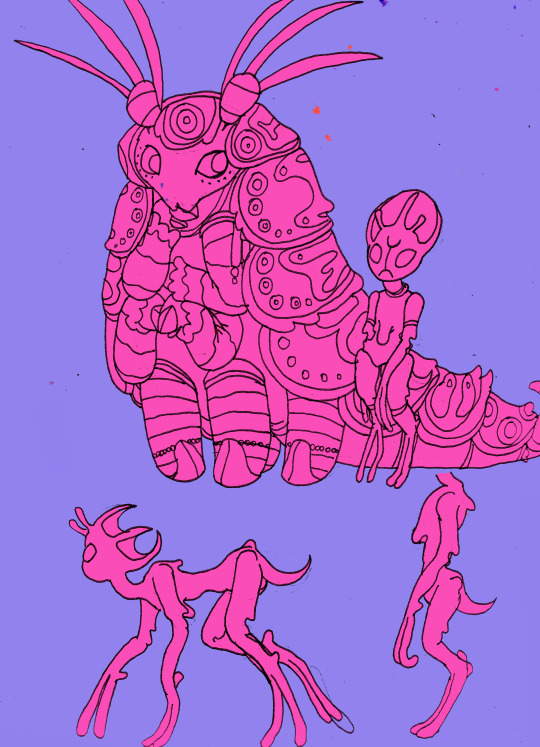
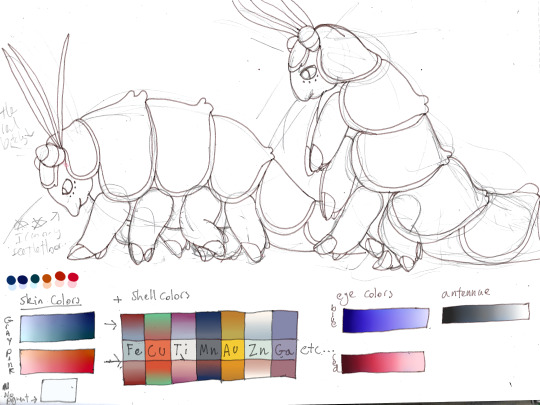
a collection of funny brainstorming doodles
first one is thinking a little bit about kkariko writing/symbology. atm, i'm focusing on rrikrik's cultural background, as kkariko are generally pretty diverse and live widespread on their home planet, which has resulted in a huge spectrum of cultural diversity. as for writing specifically, i was thinking that kkariko would probably find it best to use their "palps" to perform delicate dexterious tasks such as writing as they would have be more flexible than the exoskeleton coverings on their feet. for this script, i was thinking about a kkariko wrapping their palps in a soaked cloth and making long swooping marks on the page with them.
also thinking about the way kkariko and ki move. kkariko have four pairs of legs and for balance it would be better if they walked on two. however, i think they can run on all four pairs and stand up on one pair when threatening. their big long tail probably prevents them toppling over. as for ki... i haven't done as much thought. bipedal species are kinda tough because there's always the fear of just defaulting to human gait. i wanted ki to have super long arms and "fingers" though, so decided to give them a transitional gait for now. also look at soh's cute little tail. the off-model soh is really bad tho. but it shows the size comparision between the twos.
kkariko coloration. they have two main pigments on their bodies - one blue/gray and one pink. rika (their home planet) is very metal-rich and the metals which kkariko eat go to their shells, which take on different tones dependent on their diet. i was thinking about how these shell colors would interact with their base pigmentation as well as the effects of oxidization, as rika also has an oxygen rich atmosphere. i imagine that shells showing off rare metals and low levels of oxidization are a huge status symbol. for rrikrik, their diet is very varied in metals and they don't tend to have the luxury of staying inside, so their shell is patchy and covered in rust.
#alien species#oc#xenobiology#speculative biology#alien biology#kkariko tag#ki tag#sci fi#now you know that rrikrik doesnt take care of their shell and thats why its covered in patterns#i had a much better drawing of rrikrik soh AND a human but i havent finished it yet
43 notes
·
View notes
Text
ethnic groups* of rika
kkariko ("embodied child" in kkarikiko, a dominant language spoken throughout much of rika, originating from a mikrikka culture, part of the central ethnic grouping.)

mikkriko ("small underground child" in kkarikiko)
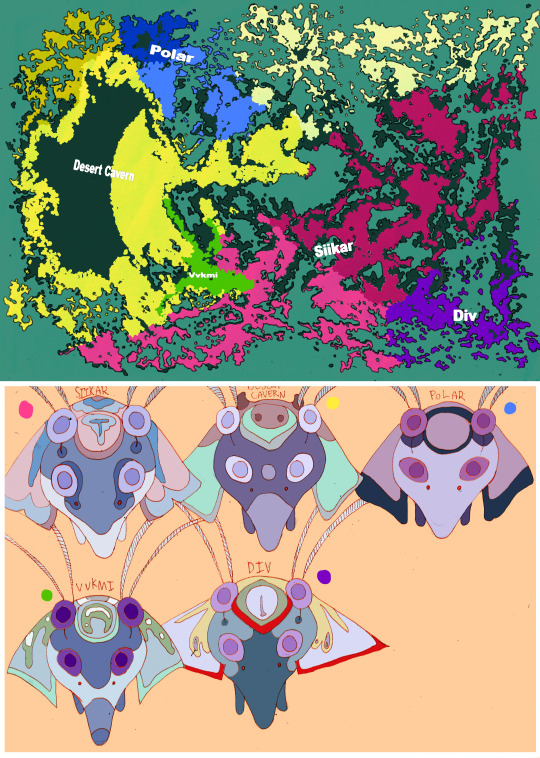
grik krog ("over the mountain" in kkarikiko)

*(these are largely political groups as opposed to genetically distinct groups. like humans, there is a huge amount of genetic diversity and interminging between geographic groups. these images are based on beauty standards and stereotypical depictions.)
#speculative biology#alien species#xenobiology#kkariko tag#worldbuilding#oc#sci fi#the divisions in color represent different culture groupings within the larger ethnic groupings#so for example. western flats as a term includes rikka cultures sinyarr cultures fori cultures and garriko cultures#(rrikrik is from a rikka culture) (karra is from a mikrikka (central) culture)#and the dark teal ground on the grik krog and mikkriko maps represent areas where those two species do not live#mikkriko live underground in cave systems. so they dont live where there arent caves#and grik krog are largely isolated in the west due to the huge big mountain range which created the western flats#grik krog arent very good at climbing mountains or swimming so they dont live on islands either
10 notes
·
View notes
Text
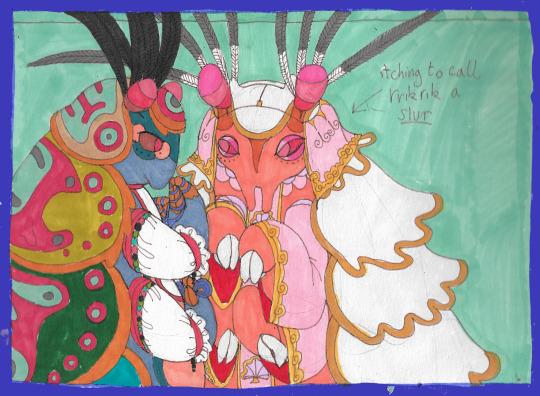
rrikrik and karra... they don't get along at all.
Rrikrik is from the Rikka cultural group, which belongs to the wider Western Flats "race". Karra, however, belongs to the Mikrikka cultural group, belonging to the Central Kkariko "race". Historically, there has been great conflict between these two cultures, with Mikrikka conquerers ravaging the Great Flat for resources and pillaging Western Flats homes. Whilst the astral colonization of Rika by the Company of Kha-Forick theoretically provided a theoretical "equalizing" of Kkariko cultures, in reality, the Company used the previously-existing power structures on Rika to their advantage.
Karra glorifies the preCompany past of Rika to a great degree. They believe that the old Central empires are a shining symbol of Kkariko greatness. Rrikrik feels like this belief is rather reductionist and harmful to the Kkariko (and Grik Krog) who suffered under those empires. Karra also has many preconceived notions about Western cultures which Rrikrik finds offensive. To Karra, the idea of a Western Flats cosmonaut is ridiculous, because they can't imagine a Western Flats Kkariko having the education to do it.
Karra was appointed as an external representative of the ICDCI on the Goodway, to make sure they don't continue their smuggling. So, whilst Karra has no actual authority over ship matters, they do have the authority of being directly from the ICDCI. Even though Rrikrik is superior to them, they use this excuse not to listen to them.
#oc#sci fi#alien species#xenobiology#speculative biology#kkariko tag#i just wanted to draw something using traditional tools to make me happy. maybe i make a kkariko woodprint soon#“race” is used here as a political term rather than a biological term#like in real life kkariko have little genetic difference between each other but have developed rigid racial identities for political reason#oh i forgot to mention that all the cosmonaut training on rika is done through central-majority political forces#so when rrikrik was in training on rika. they were the only western flats kkariko in their apprentice group#this has led them to seek out off-planet jobs with non-kkariko coworkers...#btw the company isnt around anymore they accidentally blew themselves up lolll
21 notes
·
View notes
Text

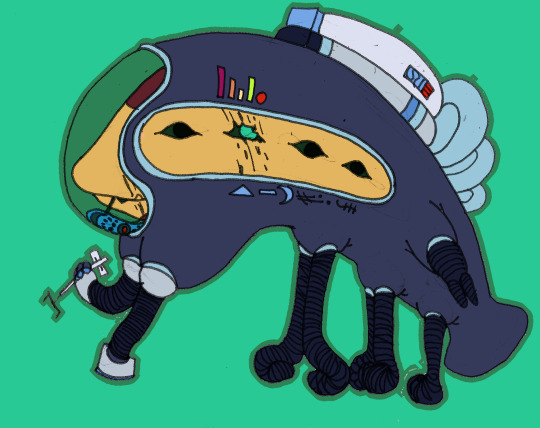
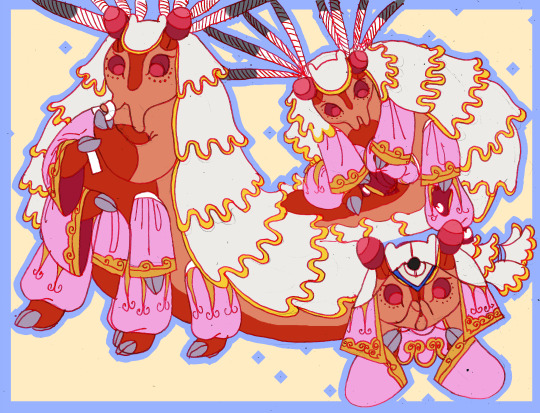

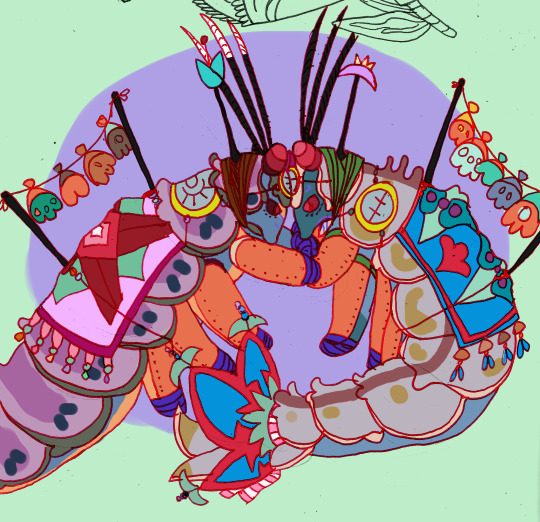
pose and behavior prompts from this post! these are super fun, ill probably do some more.
look at the worldbuilding below...
gadun fader engaged in conversation
sadum have a small sac of highly corrosive black inklike fluid at the ends of their snouts. this liquid is used defensively, offensively, and, in the case of sadum cows, as a visual language. by finely controlling the muscles in the snout, different volumes of fluid can be produced. when it comes into contact with the aquatic environment which sadum cows live in, it swirls and puffs up, resulting in unique patterns. this is how sadum cows communicate - by releasing select puffs of fluid which form into meaningful symbols. this is entirely different to the auditory language which sadum hounds use to communicate. this is fader as a child and their two parents having a conversation in an aquatic environment.
communication with other sophants is slightly more difficult. there are "universal translator" type objects available to sophants living in diverse communities, but for several systemic reasons, sadum as a species cannot use them. fader makes up for this by being proficient in a staggering amount of languages, using a series of text-to-speech programs built into their suit to communicate. they're also fluent in "universal sign", a sign language built specifically for cross species communication. like this, they can have a friendly conversation with uoovalz, their assistant, over lunch break.
gadun fader in a gaseous environment
sadum cows are uniquely challenged when it comes to astral living. whilst there are several other sophants who live in aquatic/fluid based environments and even whole fluid-filled space architecture designed for them, the waters which sadum cows live in are considered way too acidic for those sophants. and of course sadum cows cannot live in gas-based environments. combine this with intersadum sex-based oppression which limits what cows can do and where they can go, and you can see why sadum cows are considered very rare in astral environments. they largely accompany sadum hound long-term living projects, where their sole purpose is reproduction. there is one exception to this - a small but prominent all sadum cow community known as the cows of the stars, who saw freedom from sex-based oppression in the endless possibilities of astral living. they live in a single large spacecraft modified for sadum cows, and are known to fiercely repel unfriendly visitors. fader was born using artificial insemination on this ship as a cow of the stars. trained in combat, they decided to leave as a young adult after gaining a strong interest in spacecraft engineering. after a long career as a mercenary, using a custom-made atmospheric suit/mecha to fight in numerous wars, they decided to retire and decommission their old atmospheric suit into something more suited for tinkering with spacecraft.
karra moka getting dressed
this one is pretty self explanatory. the floaty sleeves which karra wears are pretty common in contemporary mikrikka fashion, but they're awfully inconvenient for space. they float about and get in the way of karra's arms, and can get caught on machinery. rrikrik has told them to get some more practical arm warmers but they have refused to do that. their puffy sleeves are even worse. however, despite karra's interest in dressing fashionably despite their situation, their fashions are pretty out of date. most kkariko clothing uses drawstrings to fasten. it's easy and fast, and can be done with the stiff claws of kkariko. the drawstrings are then either tucked away or integrated into the fashion of the clothing.
text from the comic:
rrikrik: heyy uh karra are you done-
karra: DONT LOOK AT ME WHILE IM GETTING DRESSED!
kkariko fighting without weapons
fighting without weapons has historically been the norm for most kkariko combat. when your body is made of metal, any tail smack or slap is just as good as a blade or a mace. weaponry is still a thing, mind you, but weaponless fighting and martial arts for actual combat is common and actually feasible. that was, until colonization introduced fuelled weaponry.
in many western flats culture, including the rikka cultures, ancient forms of combat have developed into a form of professional non-lethal sport fighting, which is incredibly popular with the general population. kkariko train for years, adhering to strict diets and performing exhaustive training to compete. in the ring, they decorate themselves with flags depicting the symbols of their fighting guild, and artificial tails, copper armguards, and tightly wrapped claws to increase their power. rattles and bells made from the shed exoskeletons of other creatures are hung from the back, and make a loud and intimidating noise as the assailants clash. most notable of this form of martial arts, however, is the large pole ornament each fighter wears on their head. symbols on the pole represent each fighter individually, and have deeply personal meanings originating from their clan, their guild, or even their own family. often, symbols are passed down within families. each fighter also wears a coin on the forehead, which represents their "class". rrikrik is wearing a coin like this in their portrait. (although the coin there is related to their rank as a cosmonaut, not as a wrestler. rrikrik has no skills in this field. their sibling, however, is a relatively well-known fighter in trans-flat leagues) whilst there are a myriad of different leagues, guilds, and tournaments with wildly differing rules ranging from deeply complex to "just don't kill each other", one rule remains among all - to win, one fighter must knock down the other fighter's head pole ornament without using their arms.
#speculative biology#xenobiology#alien species#sci fi#worldbuilding#kkariko tag#sadum tag#oc#the universal translator objects are a bit more complicated than just “universal translators”#perhaps the term “memetic telepathy device” is more appropriate#but in-universe they are called recieved speakers#and the specific fighting match that those two kkariko are in is probably more of a “just dont kill each other” type match#who will win? who will lose? who knows?#also the bandages on the hands are dyed purple to represent the blood of their opponent#anyway thank you so much the person who sent me the ask for karra getting dressed and fader conversation#OH YEAH. in the first image uoovalz is the pink text and fader is the blue text
17 notes
·
View notes
Text



the ancestors of kkariko, mikkriko, and grik krog.
the planet of rika used to be much wetter. huge, metal rich oceans used to cover about half of what currently stands as dry land. However, roughly 300000 years ago, a minor collision affected rika's solar orbit, moving it closer to its host star and resulting in a much warmer and dryer climate. many of the creatures living in rika's oceans now had a choice - adapt to their new dry climate or go extinct.
there were two creatures of note at this point - a small plated "worm", and a larger ten tentacled "mollusk" bearing several hard plates on its back. both of these creatures have been sighted as potential ancestors of kkariko.
thousands of years later, a small sandburrowing creature - nicknamed the sand riko. at this point in time, whilst most of the oceans had evaporated, the water under the surface of rika was still plentiful. many once-marine creatures survived by transitioning into a subterranean lifestyle, only coming up for photosynthetic life to eat. the sand riko was a species like this. sitting in its little burrow all day until dawn and dusk, it then pokes its two palps up and pokes around for "lichen" to eat. however, as rika continues to heat up, and water continues to be scarce, this method of living becomes impossible for a riko of this size.
at this point, an ecological split. some sand riko moved out of their holes, looking for more plentiful food but forgoing the lifegiving water locked under the ground. other sand riko decided to make do with less food but follow the underground channels lower, descending into caves deep underneath rika's surface. it is said that these two sand riko groups became kkariko and mikkriko respectively. lets talk about the former.
roaming about needed a much different body plan. The small stub legs of the sand riko developed into strong and muscular legs, good for gripping and pulling, with flexible exoskeleton capped grippers on the ends. to protect against the sun, the exoskeleton on the back grew larger and thicker. meanwhile, the exoskeleton on the face - the upper and lower mouthplates - became smaller and more specialized for crushing fibrous photosynthetic life. to aid in a nomadic lifestyle, these creatures developed the ability to grow a small pouch on their fronts for holding eggs and small babies. and most importantly, the creatures developed a sticky mucous membrane to keep their delicate skin protected from the harsh sun. even at dawn and dusk, it still emits UV radiation!
there is a grik krog ancestor in the background too. although they look bipedal, grik krog are technically octopedal like kkariko and mikkriko. their legs have "fused" under their exoskeleton. the only proof of their two fused legs to an outsider, is their two long spurs which they walk on. this is a grik krog ancestor, back when their legs weren't fused yet.
#oc#speculative biology#alien species#alien biology#xenobiology#sci fi#kkariko tag#grik krog tag#mikrikko tag#im working on a ref sheet for kkariko....
13 notes
·
View notes
Text
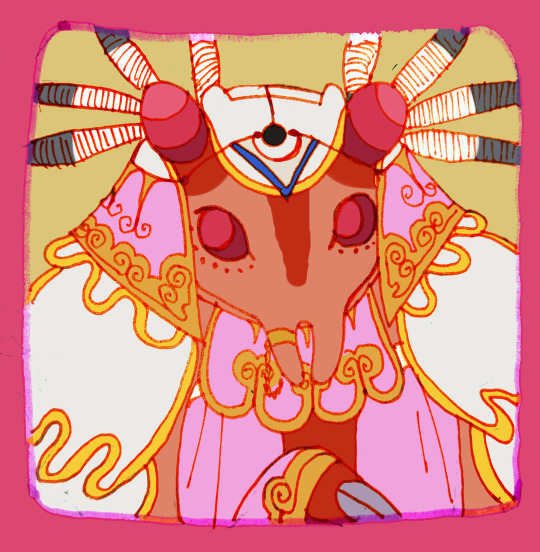
photograph of karra moka, kkariko ICDCI legal expert tasked with overseeing a minor deep space trawler after a certain incident
karra is dressed ornately, wearing a matching set of coral-pink headcover, bib, and draping armwarmers, hemmed in a golden yellow. On their headplate, they wear a metal badge indicative of their status as an ICDCI representative. Their shell is bright white rimmed with gold - this coloration is likely a "spray" designed to cover up marbled and oxidized shell as a status symbol. Their true shell color is seen on their nails.
#oc#alien species#xenobiology#speculative biology#alien tag#sci fi#kkariko tag#the only other kkariko onboard the Big Alien ship that all these ocs live on...#them and rrikrik... do not get on#i will explain what ICDCI is later my friends
12 notes
·
View notes
Text
A CLOSER LOOK AT HOME SOLAR SYSTEMS
the raakmragikk'a rrik solar system (not to scale)

raakmragikk'a rrik is an m+7 type red star, which five planets orbit. the popular names used for the astral bodies in this solar neighborhood come from kkariko language - largely central kkariko and grik languages. however, these are the names used by rrikrik, who natively speaks a rikka language. raakmragikk'a rrik translates to "shining eye of life" and appears large but red in the rika night sky. it's pretty cool, so planets can orbit closer to it and still remain temperate. despite this, rika is still several degrees k warmer than planet earth.
the first planet is known as gaakswa, translated as "red hole". it's got a diameter of roughly 27000km, with relatively strong gravity but a negilible atmosphere. however, it once had a thick atmosphere of oxygen. this oxygen has left the abundant iron found in gaakswa's exterior a rusty red color, hence the name. a moon called kkrra-gaakswa (little red hole) orbits its planet in an irregular orbit. like gaakswa, it too is red from oxidation. this has led astrologists to question if kkrra-gaakswa was once part of gaakswa and broke off due to some trauma. gaakswa appears as a small red star in the night sky from rika. one side is burning hot, whilst the other is always freezing, as it's tidally locked and has no atmosphere to disperse heat. it takes 98 earth days for gaakswa to orbit.
the second planet in sequence, rika, is the homeplanet of the kkariko, the mikkriko, and the grik krog species. it's got a diameter of 24000km, and its gravitational pull is slightly larger than on earth due to its larger size and heavier overall mass (due to having more metals in mantle) rika's structure is also relatively familar for earthlings - it has tectonics, water, photosynthetic life, an abundance of minerals, an oxygen/nitrogen rich atmosphere too. major differences lie in the proportion of carbon dioxide in the atmosphere, the overall higher temperatures and less rain, and overall highly metallic proportion of minerals found on rika. all water on rika is highly salty and full of minerals - it's too rich for earth livers to handle. the multicellular life on rika rely on this high mineral content for their existence. rika is the only celestial body in the rrik sequence to hold multicellular life at this time, although rika's two moons, rnkma (shell moon) and gzoo (light purple) both hold water, a thin and tenuous atmosphere, and unicellular life. in fact, they are named after this life. on rnkma, bioluminescent algae devour microbes in deep oceans. as rnkma spins and temperatures change, different types of microbes die and are born, and algae change their color based on what they eat. so its appearance throughout the rika year changes. gzoo has dark red photosynthetic life which dye its oceans a beautiful violet-purple color. one rika year is 212 earth days, and one rika day is 43 earth hours. so, one rika year is roughly 118 rika days. rika's axis enjoys a slight tilt of roughly 12 degrees
kzaakmrr gained its name, which means brightest star, because to kkariko with no telescopes to speak of, it looked like a bright, shining star. in fact, it's a gas giant with a diameter of 104000 km and a scant ring system. its green color comes from tiny pulverized molecules of oxidized copper in its atmospheres and chlorine gas. whilst kazzkmrr has a huge amount of tiny satellites found within its ring system and outwith, only eight have been deemed worthy enough to be given names, largely due to their historical use as mines back when rika was colonized. kzaakmrr orbits its star at a rate of 2582 earth days, and turns on its highly skewed (45 degrees) axis once every 124 earth hours.
wkgo, the "blue" star, was once the last planet known by kkariko, as it was the furthest away one able to be seen by the naked eye. wkgo is a medium-sized ice-giant with a 46000km diameter. it's got an icy cold atmosphere full of oxygen, methane, and hydrogen. culturally, it's significance is more as a fixture in rika skies than a planet in its own right. however, there has been trace evidence of long-gone oxygenated atmosphere on its third moon, sgo. wkgo takes 12240 earth days to orbit rrik, and takes 13 earth hours to rotate on its axis.
the final planet considered part of the raakmragikk'a rrik is gkikkri-go, the "furthest cousin". invisible from rika, this lonely planet was only discovered post-invasion. gkikkri-go is the most watery planet in the system by far, but due to its massively cold atmosphere, almost all its water is frozen solid. there may be running water low beneath its surface, but for the moment, kkariko aren't even sure how deep its oceans go. gkikkri-go has no satellites to speak of, and takes 89264 eath days to complete a single orbit. and even more surprising, it takes 89269 eart6h days to complete a single turn of its axis.
there is a single artificial satellite of note orbiting rika - the rika planetary council's space station, where rika-born cosmonauts are trained and intergalactic trade and communication is logged. there are seven smaller satellites which are used to transfer data.
#kkariko tag#sci fi#alien species#disclaimer i am not a professional astrophysicist#disclaimer i have dyscalculia#im just a hobbyist who likes drawing planets whose love of astrophysics singlehandedly carried them thru high school physics#and yeah kkariko digital infrastructure has only seven satellites. it is very slow.
11 notes
·
View notes
Text
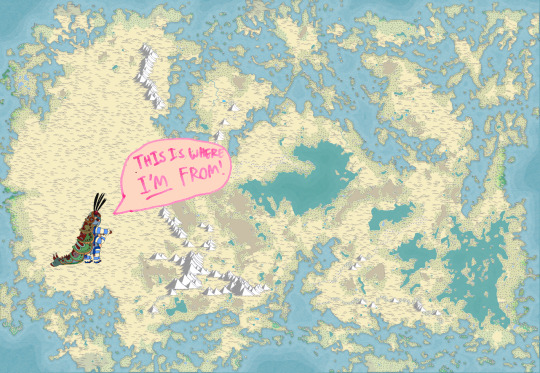
I made a very basic map of Rika (Kkariko homeplanet) using this fantasy map generator because i like making maps but don't have time to make any because work is so busy. A lot of this is subject to change! I'm kinda just brainstorming here, and I'd like to draw my own map with some minor edits in the future.
Rika is large and dry, with average temperatures between 45-20°c, as Rika is slightly closer to its main star than Earth, and its main star is larger and has a reddish tint. Rika is orbited by two small satellites - both holding water and making home for a few small bacteria and algaelike creatures. Rika has a slight rotational tilt, but it isn't that intense and doesn't really affect sun exposure that much.

(the satellites arent this close irl im just drawing it like that cus the page didnt have room lol) (also rika has artificial satellites for cosmonaut training and communication too. i just forgor)
The land is largely desertous and rocky, with very scant areas of grassland and jungle near the shores. Large salt lakes are found in the center of the single large continent found on Rika, and the water has a high mineral level compared to that found on earth (most earth animals would not be able to drink Rika water without dying). Dried up salt flat lakes are also numerous. Rain is relatively rare, but winds are intense. For this reason, many species found on Rika have evolved to need very little water. Analogous "plant life" on Rika rarely grow above Kkariko height - largely to conserve energy, as well as due to Rika's gravity. All analogous "animal life" on Rika are what humans would recognize as invertebrate-modelled - endoskeleton models do not exist on Rika. The most numerous type of creature on Rika are a coral-analogue living both on land and underseas. There are three "sapient/sophonant" species living on Rika, the Grik Krog, the Kkariko, the Mikkriko, which Kkariko are the most numerous of. Rika was colonized by a major spacefaring empire several generations ago. This empire fell in a huge war and the people of Rika have their freedom now, but the aftermath of this empire's extractive and highly destructive culture have left a huge mark on Rika's climate. I'll make a post about Grik Krog and Mikkriko later.

Roughly a third of the planet consists of a flat, gently sloping desert beyond the largest mountain range found on Rika. This desert, known as the Great Flat by many Kkariko cultures. The Great Flat is inhabited by several nomadic/seminomadic groups of Grik Krog and Kkariko (this is actually the only area where Grik Krog are currently found). Rrikrik is from this region! Garik is a notable nomadic pastoralist clan from the Rikka ethnic group in this area.
(rrikrik point high quality version below vv) (rika map without rrikrik's speech bubble obscuring the meeting place of three tectonic plates below vv)
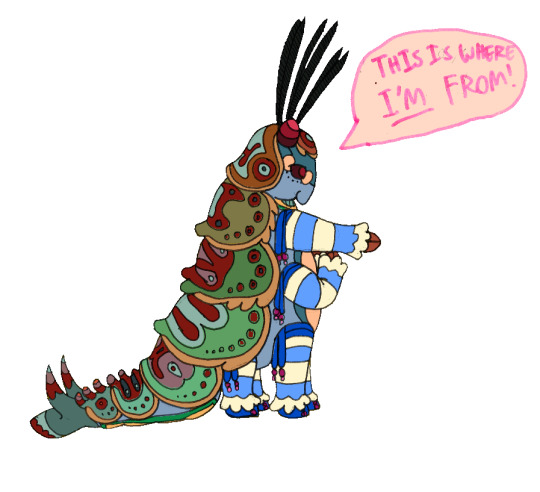
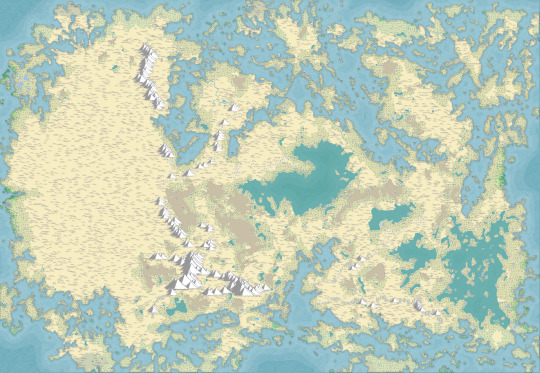
#oc#alien species#worldbuilding#speculative biology#xenobiology#sci fi#kkariko tag#rrikrik is so proud to show their homeland!#im still thinking about days and years on rika....#the story that rrikrik and co have rn is the story of all these disparate planets trying to decolonize and rebuild together#after the mutually assured destruction of these four major space empires#kkariko and mikkriko are related. but grik krog are not as closely related to those two
8 notes
·
View notes
Note
i just came across your work and its absolutely stunning. the way you color things and the patterns you use remind me of like a warm quilt
needless to say i really like it :)
ahhh thank you that's such a kind compliment!! old quilts and other textiles are definitely a big inspiration for me so having my art compared to them means a lot :3

(rrikrik heart for u)
4 notes
·
View notes
Text
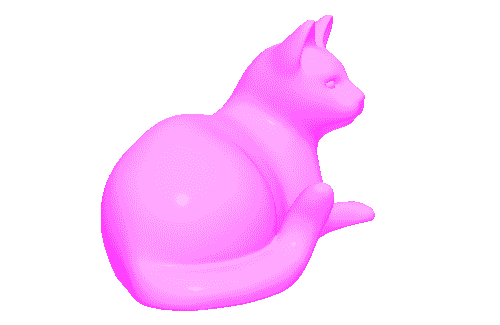
hellllo yous can call me catseas :) they/them or she/her pls! this is my specbio/sci fi alien species posting blog - my other artblog is here. this is not my mainblog btw
i am primarily a traditional artist. i color some work digitally, but linework is always done by hand. i also do textile art and printmaking
kkariko tag
ki tag
atil tag
alerian tag
all the species i write about are "creative commons" - i dont "own" them but i kind of put them into a physical form. so you can make your own ocs of those species if you'd like, or even write stuff about them. you can also use my art if you'd like. the only thing i really protest to is people selling my art.
if you'd like to talk to me, my messages are open!
#i dont like owning language for my ocs it feels innapropriate#even the term oc feels wrong tbh#anyway this is for pinning
1 note
·
View note